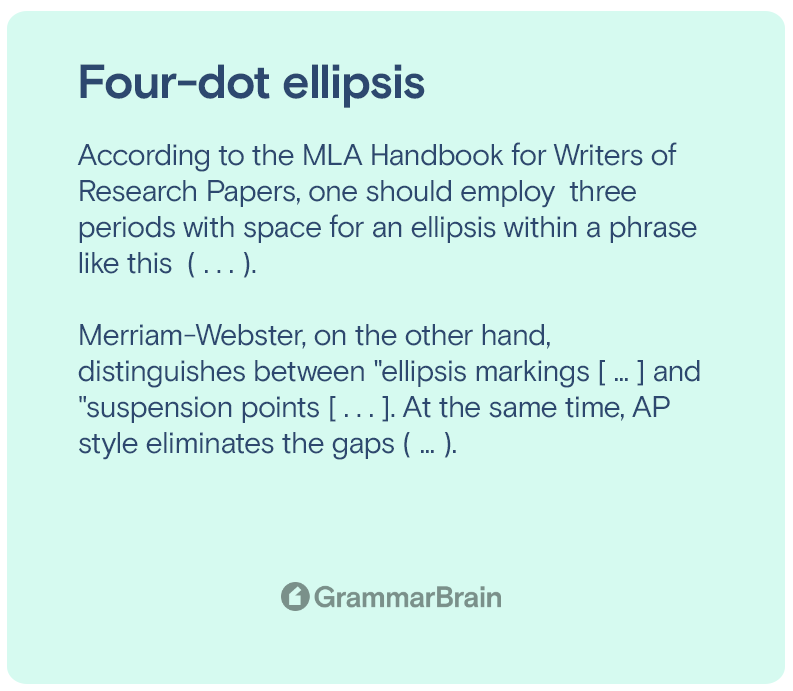What is the four-dot ellipsis? The four-dot ellipsis is a non-standard ellipsis form. But before delving into the details of using the four-dot ellipsis, let’s first understand what an ellipsis is.
Four dot ellipsis and regular ellipsis
The three-dot ellipsis may be found in anything from dissertation papers to SMS messages. It denotes the omission of one or perhaps more words in a sentence.
Here are examples of using the regular (3-dot) ellipsis:
But, if you genuinely desire to wow your grammar-obsessed buddies, try on the four-dot ellipsis. But before that, you should understand how one should use it.
When this illusive punctuation mark follows a grammatically perfect sentence, it is usually employed at the conclusion of a phrase. It typically means you’re skipping a phrase and moving on to the next one.
The ellipsis facilitates efficient writing by enabling us to shorten information or include just elements that we consider pertinent to our readers. An ellipsis can be employed at the beginning, mid, or conclusion of a phrase.

What is a four dot ellipsis?
A 4-dot ellipsis does not exist in the truest sense. Three dots denote the omission of content in a citation. A fourth dot implies that the missing content contained at least one phrase.
The Chicago Manual of Style goes into considerable detail about how to use the ellipsis, relating to the three and four dots.
When should you use the four-dot ellipsis?
If a whole sentence or multiple sentences come before an omission, we’ll use a period preceding the three-dot ellipsis mark, creating a sum of four dots.
| Grammar Rule | Ellipsis |
| AP Style | … |
| MLA Style | . . . |
Let’s take some examples of Ellipsis with four dots:
Original content- Smartphones and tablets have transformed the manner in which we engage. We no longer need to visit or phone our neighbors to speak with them; instead, we nowadays can send an email or a message directly through social networking sites.
Four dot ellipsis content- Smartphones and tablets have transformed the manner in which we engage. … we nowadays can send an email or a message directly through social networking sites.
Original content- We can now obtain knowledge for ourselves, whereas we might have had to visit specialists much more frequently in the past. Using accessible applications, we can set our television and even check on our neighbours. Yes, we have grown a little more intelligent and efficient.
Four dot ellipsis content- We can now obtain knowledge for ourselves, whereas we might have had to visit specialists much more frequently in the past. … We have grown a little more intelligent and efficient.
Take notice of how we used space in our four-dot ellipsis. We include the closing period at the conclusion of the sentence, followed by a space, the ellipsis, and then another space. We are using a lowercase letter if the paragraph after the ellipsis is a part of the following phrase instead of the beginning of it.
Should there be spaces or not?
Not all style manuals agree regarding whether or not the dots in the ellipsis should be separated by spaces.
According to the MLA Handbook for Writers of Research Papers, one should employ three periods with space for an ellipsis within a phrase like this ( . . . ).
Merriam-Webster, on the other hand, distinguishes between “ellipsis markings [ … ] and “suspension points [ . . . ]. At the same time, AP style eliminates the gaps ( … ).
Inside this article
Fact checked:
Content is rigorously reviewed by a team of qualified and experienced fact checkers. Fact checkers review articles for factual accuracy, relevance, and timeliness. Learn more.
Core lessons
Glossary
- Abstract Noun
- Accusative Case
- Anecdote
- Antonym
- Active Sentence
- Adverb
- Adjective
- Allegory
- Alliteration
- Adjective Clause
- Adjective Phrase
- Ampersand
- Anastrophe
- Adverbial Clause
- Appositive Phrase
- Clause
- Compound Adjective
- Complex Sentence
- Compound Words
- Compound Predicate
- Common Noun
- Comparative Adjective
- Comparative and Superlative
- Compound Noun
- Compound Subject
- Compound Sentence
- Copular Verb
- Collective Noun
- Colloquialism
- Conciseness
- Consonance
- Conditional
- Concrete Noun
- Conjunction
- Conjugation
- Conditional Sentence
- Comma Splice
- Correlative Conjunction
- Coordinating Conjunction
- Coordinate Adjective
- Cumulative Adjective
- Dative Case
- Determiner
- Declarative Sentence
- Declarative Statement
- Direct Object Pronoun
- Direct Object
- Diction
- Diphthong
- Dangling Modifier
- Demonstrative Pronoun
- Demonstrative Adjective
- Direct Characterization
- Definite Article
- Doublespeak
- False Dilemma Fallacy
- Future Perfect Progressive
- Future Simple
- Future Perfect Continuous
- Future Perfect
- First Conditional
- Irregular Adjective
- Irregular Verb
- Imperative Sentence
- Indefinite Article
- Intransitive Verb
- Introductory Phrase
- Indefinite Pronoun
- Indirect Characterization
- Interrogative Sentence
- Intensive Pronoun
- Inanimate Object
- Indefinite Tense
- Infinitive Phrase
- Interjection
- Intensifier
- Infinitive
- Indicative Mood
- Participle
- Parallelism
- Prepositional Phrase
- Past Simple Tense
- Past Continuous Tense
- Past Perfect Tense
- Past Progressive Tense
- Present Simple Tense
- Present Perfect Tense
- Personal Pronoun
- Personification
- Persuasive Writing
- Parallel Structure
- Phrasal Verb
- Predicate Adjective
- Predicate Nominative
- Phonetic Language
- Plural Noun
- Punctuation
- Punctuation Marks
- Preposition
- Preposition of Place
- Parts of Speech
- Possessive Adjective
- Possessive Determiner
- Possessive Case
- Possessive Noun
- Proper Adjective
- Proper Noun
- Present Participle
- Prefix
- Predicate



